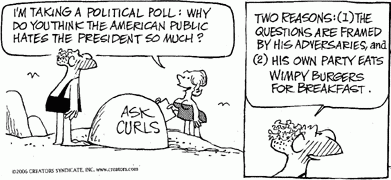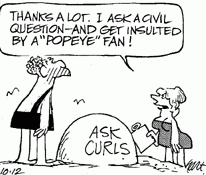 Some intelligence on the Vatican
Some intelligence on the VaticanInside the Vatican is Robert Moynihan's monthly magazine on activities within the highest levels of the Roman Catholic hierarchy. Dr. Moynihan holds a Ph.D. in medieval studies from Yale and is a longtime Vatican journalist with an insider's contacts and perspectives. His magazine's editorial policy is closely aligned with the policies of the pope. Although Inside the Vatican is not an official house organ, one can say it faithfully plays the tunes called by Rome.
In fact, when the magazine departs from Church policy at all, it's more a matter of being “more Catholic than the pope” than it is any form of rebellion against Church doctrine. When not lamenting the failure of Benedict XVI to swiftly reinstate the Latin rite Tridentine mass throughout the world, Inside the Vatican also counsels patience to those who pine for the days before Vatican II.
The latest issue, which bears an October 2006 date, offers a news article on the controversy stirred up by the dismissal of the outspoken director of the Vatican observatory. The director had directly challenged some statements in praise of intelligent design “theory” by Cardinal Christoph Schönborn. Under the title Intelligent Design?, writer Charles Collins describes the sequence of events and offers statements from some of the participants.
Intelligent Design?The Roman Catholic Church, like other Christian denominations, believes that human beings have God-given souls. Unlike many Protestant sects, however, Rome has usually been careful to avoid making dogmatic pronouncements about the literal truth of the creation passages in Genesis. One would like to think the Church learned some lessons in its fight with Galileo.
A new head of the Vatican observatory is appointed shortly before Benedict XVI meets with his old doctoral students in Castel Gandolfo to discuss the theory of evolution.
By Charles Collins
When the August 19th announcement came that Father George Coyne, SJ, had retired as the director of the Vatican Observatory, a cheer went up in the Intelligent Design community in the United States.
Intelligent Design advocates believe that the complexity of the universe and biological systems offers scientific proof that there is an intelligence behind creat1on. The theory differs from “creationism” in that it does not identify this “intelligence” as being the biblical God. Most scientists contend that the theory is “creationism through the back door,” and the theory has virtually no support from non-Christians.Father Coyne, who had headed up the Vatican's chief scientific facility since 1978, is a long-time critic of the theory. “It is a religious movement. In my mind there is no doubt about it,” he said two years ago. “For example, there are arguments from some Intelligent Design people that say the chemical complexities of the human brain are such that it would be impossible that the human brain could be assembled without an intelligent design I don't see that it is necessary to have a person have a designed plan, an intelligent plan, to make the human brain come to be. I just don't see it. It could be! But from our scientific knowledge it is not necessarily so.”
Intelligent Design advocates are mostly Evangelical Protestants in the United States. The Michael Polanyi Center at Baylor University, the most prominent university of the Baptist denomination, was the first academic think-tank devoted to Intelligent Design. In 1999, the Center opened in Baylor's science department.Father Neuhaus is a former Protestant minister who converted to Catholicism. Few Catholics are as fervent as converts. Neuhaus, however, brings with him into the Church some of the dogged combativeness that characterizes conservative Protestantism, infusing the Roman church with a pugnacity toward the secular truths of science that was alien to it (at least since the time of Leo XIII, the pope who established the Vatican observatory)
Proponents of Intelligent Design have long tried to expand their influence, both internationally and among Catholics.
This has proved difficult. Pope Pius XII wrote in Humani generis that the Church does not forbid the teaching of evolution. In 1996, Pope John Paul II told the pontifical Academy of Sciences that evolution is “more than a hypothesis.”
Many Catholic scientists seem perfectly comfortable with the predominant scientific theories. “Pope John Paul II said philosophy and theology have to respect the independence of the scientific approach to things,” Father Coyne said. “They have to admit the great success of the scientific method.”
However, over the past few years, Intelligent Design has received some support from Catholic quarters.
Intelligent Design supporters have been given access to the pages of the journal First Things, which is edited by a Catholic priest, Father John Neuhaus. Father Neuhaus has said he thinks the theory is sound and in accordance with Catholic teaching.
Just who is Christoph Schönborn, cardinal archbishop of Vienna? The general public can be forgiven for not knowing. Just as Cardinal Wojtyla was an unknown Polish prelate until called to the throne of Peter as Pope John Paul II, Schönborn has been a relatively obscure German cardinal. His stock is supposedly rising in Church ranks with the ascension of his mentor, Josef Ratzinger, as Pope Benedict XVI. His major claim to fame to date was his role as director of the new Catholic catechism, which gives him a leading role as one of the Church's educators and doctrinal apologists.The biggest coup for the movement was when the archbishop of Vienna, Cardinal Christoph Schoenborn, published an op-ed in The New York Times supporting the concept of design, and attacking aspects of evolutionary theory. The cardinal was sponsored by The Discovery Institute, a U.S.-based think tank which promotes Intelligent Design. Cardinal Schoenborn came under heavy criticism from Father Coyne for his article.
At a January 31st lecture given at Palm Beach Atlantic University in Florida, the Jesuit said the Austrian cardinal was misinformed on several points.
“One, the scientific theory of evolution, as all scientific theories, is completely neutral with respect to religious thinking; two, the message of John Paul II, which I have just referred to and which is dismissed by the cardinal as 'rather vague and unimportant,' is a fundamental Church teaching which significantly advances the evolution debate; three, neo-Darwinian evolution is not, in the words of the cardinal, 'an unguided, unplanned process of random variation and natural selection'; four, the apparent directionality seen by science in the evolutionary process does not require a designer; five, Intelligent Design is not science despite the cardinal's statement that ‘neo-Darwinism and the multi-verse hypothesis in cosmology [were] invented to avoid the overwhelming evidence for purpose and design found in modern science.’”
Cardinal Schoenborn later issued a clarification of his remarks. He said he was speaking more about philosophy than about physics.
Some even rank the young German cardinal as a potential successor to Benedict, one of the papabili (an Italian word that basically means “pope-worthy”). A website devoted to the activities and sayings of the cardinal, The Schönborn Site, is nothing less than a fan club. You can even get T-shirts and other Schönborn gear in the on-line souvenir shop. The New York Times editorial and the cardinal's lectures on evolution are also posted there.
Collins doesn't talk about the source of the material in Schönborn's New York Times editorial, but it's not ghostwritten by minions of the Discovery Institute (unlike Ann Coulter's recent anti-evolution diatribes). As one of the Church's leading scholars on the role of science in society, Schönborn was merely offering the latest in a series of Roman Catholic assaults on what they call neo-Darwinism. As the cardinal described it in his editorial, neo-Darwinism is not simply a different term for the “modern synthesis”; rather, Schönborn is criticizing “an unguided, unplanned process of random variation and natural selection.”
The cardinal's argument, in his editorial and subsequent lectures, is less a brief in favor of Intelligent Design creationism than it is a rallying cry for theistic evolution. Unlike some of Schönborn's more eager supporters, the cardinal himself posits that the fact of evolution is well demonstrated. He laments, however, the failure of evolutionists to acknowledge the guiding hand of God. In that sense, he makes common cause with the proponents of ID creationism, whose argument against the sufficiency of natural evolutionary mechanisms serendipitously aligns with his own. (Or perhaps it's not serendipity. The IDists are, as a rule, overt religionists who merely leave their principal motivation unvoiced when they seek to undermine science.)
This confusion of the roles of science and philosophy has often been a cause of confusion in the debate over Intelligent Design. Many scientists say that belief in an “intelligent designer” can come about through philosophical reasoning, but that does not mean that it is a scientific theory. Two years ago, Father Coyne even hosted a dialogue bringing scientists and theologians together to discuss whether or not the universe has a “purpose.” During the meeting, Father Coyne said that scientists have to realize that they cannot provide the answers to all the questions. He said it is the “ultimate questions” which science is least qualified to tackle. These include the existence of God and the spiritual nature of the human being.All the more reason, therefore, that the Roman Catholic Church will maintain a friendly but distinct separation from the ID crowd. It doesn't like to tie itself to losers.
The Vatican conference was co-sponsored by the Templeton Foundation, which used to sponsor research into Intelligent Design. This support stopped when scientists associated with the movement were not able to provide valid research supporting the theory.
“From the point of view of rigor and intellectual seriousness, the intelligent design people don't come out very well in our world of scientific review,” Charles L. Harper, Jr., senior vice president at the Templeton Foundation, told Salon Magazine in 2004.
Many Evangelicals are also coming to his conclusion. Two years after the Michael Polanyi Center opened, Baylor moved it from its science faculty to the department of theology.
Given the fact that Intelligent Design seems to be in retreat, there was some shock when the Daily Mail published a story on August 23rd entitled “Pope Sacks Astronomer Over Evolution Debate.” The English newspaper claims that Pope Benedict had Father Coyne replaced because of his very public opposition to Intelligent Design.Some celebratory headlines announcing Coyne's retirement (or “sacking”) are cited at Schönborn Sightings, the blog affiliated with the cardinal fan club. It links to Vatican Dumps Darwinist-Boosting Astronomer from LifeSiteNews (a “pro-life” source) and Pope Replaces Intelligent Design Critic at Observatory from the Religion News Service.
With the election of Pope Benedict XVI last year, some supporters of Intelligent Design thought they might get papal approval for their movement. Cardinal Joseph Ratzinger had been critical of some aspects of evolutionary theory before his election.
Many observers thought it was significant that Father Coyne was replaced shortly before a September 1-3 meeting of Josef Ratzinger's old doctoral students in Castel Gandolfo. This is an annual gathering which began years before Ratzinger's election as Pope.
This year's meeting focused on... evolution. Yet one of the participants, Father Joseph Fessio, SJ, says the theory of Intelligent Design never came up.
“It wasn't that at all,” Father Fessio, provost of Ave Maria University in Florida, told Reuters. (Father Fessio is also the head of Ignatius Press, which publishes Pope Benedict's books in English.) The talks were exclusively about evolution, he said, and particular attention was given to the improper use of evolutionary theory in other areas, such as social science.
The talks given at the meeting will be published as a book by the Vatican later this year.
Fessio implied that the Intelligent Design movement is exclusively an American Evangelical theory, and offers nothing for Catholics. “There's a controversy in the United States because there is a lack of awareness of a thing called philosophy,” Fessio told Reuters. “Evangelicals and creationists generally lack it and Catholics have it.”It was undoubtedly true that the pope would eventually accept Coyne's request to be allowed to retire. There is no reason to think that Coyne is making excuses when he says he was ready to step down. Is there, however, a subtext to the pope's timing in accepting it? Maybe yes, maybe no. Pontiffs are political creatures, but they come to their high office after lengthy careers in the Church—careers in which they learn patience and taking the long view. Benedict XVI has already shown his disinclination toward swift action.
He agrees that proponents of Intelligent Design are confusing disciplines. “When you look at the world and see what appears to be order and design, the conclusion that there is a designer is not a scientific conclusion; it's a philosophical one,” he said.The new head of the observatory, Father Jose Funes, SJ, says that he does not understand the furor, and that Father Coyne, at the age of 73, just wanted to retire. “I just want to build on the wonderful foundation that Father Coyne has established here,” he told Vatican Radio.
Father Coyne also responded to the accusations that he was asked to resign because of his beliefs.
He says he had submitted his resignation several times, and had asked the Holy Father to appoint a new person who can offer new input to the important work of the observatory.
In an e-mail sent to journalists, Father Coyne wrote: “The work of the Vatican Observatory under my directorship has been enthusiastically supported by John Paul I, if for ever so short a reign, by John Paul II, in many marvelous ways, and now by Pope Benedict XVI. Pope Benedict, to my mind, has renewed his enthusiastic support for the observatory's work by the appointment of Father Jose Funes and I am grateful to Pope Benedict for his enduring and loving care for this work of the Church.”
Father Coyne will still have a significant role at the observatory. After a year-long sabbatical, he will return full time to Castel Gandolfo. He will also continue to head the Vatican Observatory Foundation, which seeks out financial support for the work of the observatory.
As for Schönborn, a relatively young cardinal with his eye possibly glancing toward the papal throne, expect him to demonstrate to his Church brethren that he possesses the serene patience that epitomizes Vatican policy. And he'll keep giving his catechetical lectures, many of which touch on evolution and so-called neo-Darwinism. Expect to hear and see more. Maybe even on a T-shirt.
The living fossil that is the Roman Catholic Church is not yet done.

















































